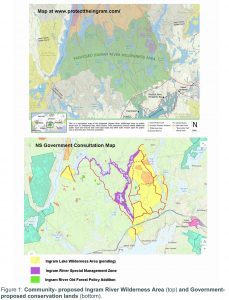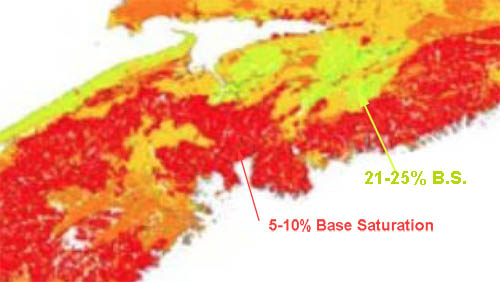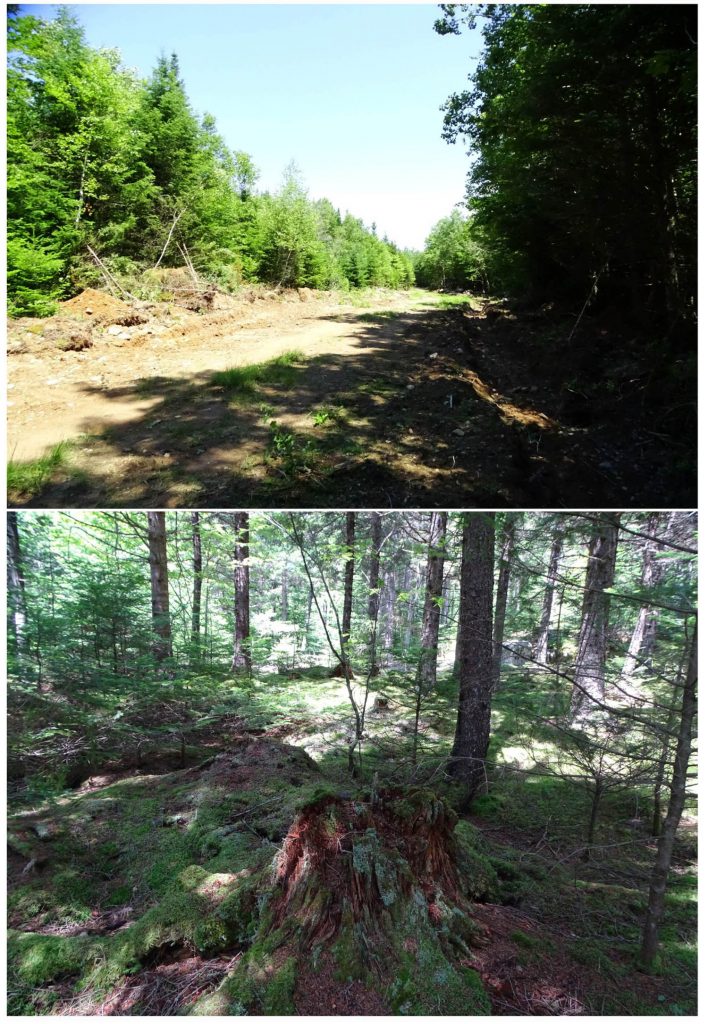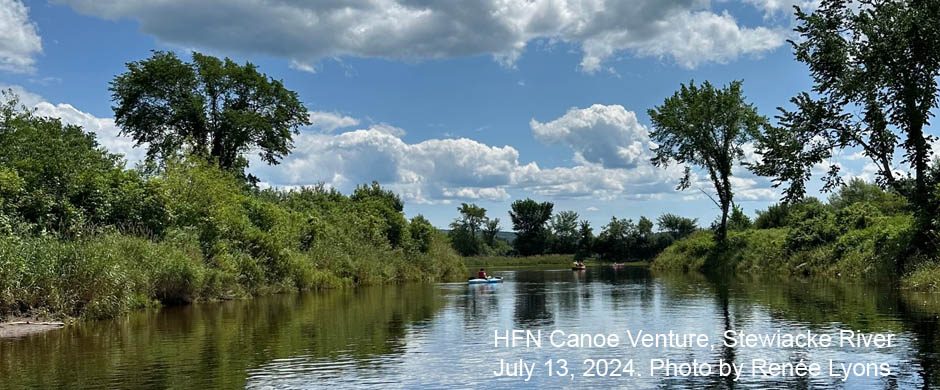Nova Scotia Parks and Protected Areas Summer 2021 Consultation
Comments submitted on Sep 27, 2021 on behalf of the Halifax Field Naturalists and the Nova Scotia Wild Flora Society by David Patriquin (Member of the Conservation Committee of the Halifax Field Naturalists & Member of the Board of the Nova Scotia Wild Flora Society)
1. Additions to four wilderness areas, to one Provincial Park and designation of two Provincial Parks
We are highly supportive of the specific additions proposed for 4 wilderness areas (Blue Mountain – Birch Cove Lakes Wilderness Area – 15 ha of Crown land between Kearney Lake and Charlies Lake; Devils Jaw Wilderness Area 38 ha which will add intact mature hardwood forest with lake frontage; Fourchu Coast Wilderness Area – 191 hectare addition in multiple parcels; Trout Brook Wilderness Area – 40 ha addition will add old hardwood forests on steep hills above and along Trout Brook), the addition of a total 74 ha of Crown land including the existing Upper Tantallon Provincial Park to Jerry Lawrence Provincial Park, the proposed designation of Carters Beach (95 ha) as the Carters Beach Provincial Park and the proposed designation of a “ small, 10 hectare park reserve with coastal frontage on Port La Tour” as the “Port La Tour” Provincial Park.
All of these areas, while small, add significantly to the ecological and recreational values of Nova Scotia’s Parks and Protected Areas. We appreciate the continuing efforts to make such additions to our existing system of Parks and Protected Areas.

Figure 1: Community- proposed Ingram River Wilderness Area (top) and Government-proposed conservation lands (bottom).
Click on image for larger version
2. The Proposed Conservation Lands at Ingram River
We are supportive of protecting the additional lands cited in the Government’s Proposed Conservation Lands at Ingram River. However, we urge the government to go further and protect the full suite of lands in the community-proposed Ingram River Wilderness Area (view Figure 1 at right).The former represents roughly 4,200 hectares, or just over 26% of the Ingram River Watershed, the latter, roughly 15,800 ha, encompassing close to half of the Ingram River watershed (from www.protecttheingram.com).
As noted on www.protecttheingram.com, under the current government proposed area, roughly 22% of the St. Margaret’s District would be protected which is 8% below the provincial average, while protecting the larger area would bring the area up to the provincial average. – so the “ask” is not excessive. Protecting the larger area would be an initial, significant addition in the context of the new PC government’s commitment to increasing the legally protected area in Nova Scotia to 20% by 2030 (from the current level of approx. 14%). There is widespread support for protecting the larger area, an example of which was expressed by HRM Mayor Savage (view www.protecttheingram.com/). The larger area would provide for much more wildlife connectivity and eventually, old forest habitat – both currently at a premium. It would also increase carbon sequestration as compared to the status quo.
It appears that the major obstacle to protecting the larger area is resistance from the industrial forestry sector, as expressed by the WestFor General Manager in the August 2021 WestFor newsletter (view extract). Leaving aside the patent mis-representations of what would happen to recreational access if the Government-proposed area were protected (e.g., the contention that one could no longer hunt, fish, or camp in these lands), it’s understandable that the forest industry would be concerned about the loss of some wood supply from Crown lands. However comments by the WestFor Manager to the effect that forest productivity and multi- use benefits can be maintained only if government steps aside must be challenged.
Some of the elders in our two naturalist societies have been visiting this area for close to 50 years. One member comments that Bowater was overall a good forest manager; they cut on relatively long rotations, some of it selective logging, and left many areas with old trees or other special ecological features untouched. He goes on to state that under WestFor management he has noted the logging of younger forests with very little left untouched and that the area being logged and new roads are increasing at a seemingly furious pace in the last few years as compared to the years under Bowater management.
Such comments are anecdotal but the gist of the contention related to harvesting is supported by a NS Provincial Landscape Viewer map showing the forest development stage layer for the area (Fig 2 below): note that the high concentration of the two most advanced developmental stages in South Panuke Wilderness Area and the generally low concentration of these stages and the prevalence of establishment level forest elsewhere.

Fig 2. Forestry Development Class (top) and location of Crown and Protected lands (bottom)
Click on image for larger versions
Evidently the WestFor group wants to log as many of the parcels of green and purple (forests in Mature and Multi-aged/Old Forest development stages) outside of legally protected areas as they are able, otherwise settling for Young Forest. What are the consequences for old forest habitat and connectivity of old forest once those are mostly gone? What are the consequences for the potential of these forests to produce wood in the future, except as chips and small diameter wood for mass timber?
Also of major concern is the very low Base Saturation of the soils in this area (5-10%; view Fig 3 below), a consequence of the inherently poor buffering capacity of the soils and bedrock combined with acid rain over much of the 20th century and made worse by intensive harvesting (re:Miller et al., 2007; Noseworthy 2011; Keys et al., 2016).

Fig 3.Base Saturation of forest soils Extracted and modified from Fig 3 in Keys et al., 2016. Soils in the Ingram River area are highly base depleted. Click on image for Keys et al., 2016
Low nutrient concentrations favour softwoods over hardwoods because of the lower nutrient requirements of the softwoods; softwoods are encouraged also by most forestry practices in the area, yet looking to the future, we should be encouraging more hardwoods which, in general, are better adapted to warmer climates (Taylor et al., 2017); they are also are less fire-susceptible than softwoods, surely a benefit of more hardwoods as we experience more droughty summers.
Based on the mixed and hardwood forests we see today in pockets not harvested historically, it seems likely that the natural forest in the area – that which prevailed before intensive harvesting and softwood oriented management – was a more mixed forest than we see today.
Ostensibly, implementing the Lahey Recommendations would reduce the negative impacts of forestry by requiring ‘Ecological Forestry‘ over much of the area outside of the government- proposed conservation lands but within the larger community-proposed area, and concentrating High Production Forestry over a smaller area but on the most productive lands.
Where will those highly productive lands be located in this now highly nutrient-depleted and intensively harvested landscape? Will they be on the few remaining patches of green and purple (forests in Mature and Multi–aged/Old Forest development stages)? If so, they would then be logged and managed as softwood plantations, i.e. taken out of an Old Growth trajectory.
Ecological Forestry as prescribed in the Final Version of the Silvicultural Guidelines for the Ecological Matrix would allow for more forest in the matrix outside of the High Production Forestry sites to grow old (or at least older than under current management). However it may not be very effective in changing the composition of the forests from predominantly softwoods to more mixed forests because the goal of nutrient management for Ecological Forestry as prescribed in the Final Version of the Silvicultural Guidelines for the Ecological Matrix is only to maintain current nutrient levels; there is no provision, it appears, to allow the nutrient status to improve on soils which are severely calcium depleted as is the case over most of the Ingram River Watershed.
Thus even Ecological Forestry would, in this landscape, be highly biased towards softwoods; and it would slow if not eliminate altogether, the long term recovery of soil nutrients necessary to support many animal and plant species that have thrived in these landscapes in the past.*
*e.g., view C.M. Beir et al. 2012. Changes in faunal and vegetation communities along a soil calcium gradient in northern hardwood forests. Canadian Journal of Forestry Research 42: 1141–1152; A. Jeziorski, et al. 2008. The widespread threat of calcium decline in fresh waters. Science 322, 1374; . S.E. Pabian & M.C. Brittingham. 2012. Soil calcium and forest birds: indirect links between nutrient availability and community composition. Ecosystems 15: 748–760.
These are some of the concerns we have about continuance of current forestry practices over a large area of the Ingram River watershed as would occur under the current government proposal for protecting ~4,200 ha in the Ingram river watershed, and illustrate why we support the community proposal for protection of the larger “Ingram River Wilderness Area ( ~15,800 ha).
Who we are
The Halifax Field Naturalists (HFN), founded in 1975, seeks to “educate ourselves and the public at large in the natural history of Nova Scotia.” Current membership is 111 paid up members. We have a website at www.halifaxfieldnaturalists.ca.
The Nova Scotia Wild Flora Society (NSWFS), founded in 1990, is dedicated to the appreciation and conservation of wild flora and habitat in Nova Scotia. Currently we have 47 paid up members. We have a website at www.nswildflora.ca.
Both groups are Halifax based for in-person and now some virtual meetings, but we have members from all over the province, and our field trips occur throughout Nova Scotia. Whenever possible, meetings and field trips of HFN and NSWFS are open to the public at large. In the last several years we have seen rising interest in our activities, reflecting the increased appreciation generally today of nature and of the many and special opportunities we have in Nova Scotia to enjoy nature.
Many of our members are involved as individuals in trail organizations and in specific conservation efforts. As naturalist societies, we are often asked to support conservation efforts by visiting specific sites and documenting the flora and fauna, and by writing letters of support.

Fig 4: North of Clay Lake, July 11, 2021 new forestry road (above) and adjacent forest (below). The stand is even-aged, predominantly red spruce; it was likely managed with both pre-commercial and commercial thinning after clearcut of a mixed multi-aged old forest (note large stump in foreground) about 40 years ago. We searched far and wide, but in vain, for patches left untouched. Nor did we find any large old snags or larger fallen wood in this landscape; and only the occasional hardwood (all red maple).

Fig 5: View looking north across Big Indian Lake July 11, 2021. It is a magnificent landscape, but one that is managed to maximize softwood production and is largely devoid of habitat for old forest species.
Ultimately, the end-game must be to achieve a paradigm shift from industrial forestry to responsible public land stewardship — fundamentally, a transformation from an outdated mindset locked in on commercial resource extraction to a vision that embraces biodiversity conservation and sustainable use. – Dale Smith
In other words, I have concluded that protecting ecosystems and biodiversity should not be balanced against other objectives and values as if they were of equal weight or importance to those other objectives or values. Instead, protecting and enhancing ecosystems should be the objective (the outcome) of how we balance environmental, social, and economic objectives and values in practising forestry in Nova Scotia. – William Lahey
When I went on these lands twenty or so years ago, I would consistently see 5 or 6 deer, 4 or 5 red-tailed hawks, a barred owl or two, lots of nighthawks and many warblers…today I often see nothing, not even a porcupine. I have heard barred owls but I have not seen one in years. – Naturalist
